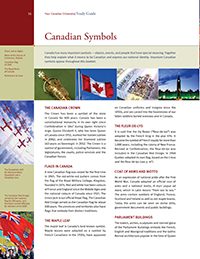
Click to enlarge image
CANADIAN SYMBOLS
Let’s talk about Canadian symbols. Close your eyes and think: what is the first picture that comes to your mind?
Flag and a maple leaf. What colour is the maple leaf? Quick! Don’t think too much… red? OK. Now draw the picture of Canada’s flag in the air – did you remember the red borders? If no, draw it on the paper – this way you will never forget.
How long has Canada been using the maple leaf flag? Since 1965. That’s how many years? I will have to use the calculator.
What about before? Can you guess which country flag was used before? What language do we speak in Canada? English. English language – British flag. (British flag has a funny name – “Union Jack” – but officially it’s called “Union Flag”). So, in 1964, this guy, Lester B. Pearson – Prime Minister at that time, Liberal party – has this idea: let’s have our own flag! Not everybody agreed – there was a Great Flag Debate! But why not? Maple leaf has been a Canadian symbol since 1700s!!!
There were many ideas for how the new flag should look like – 2,000 suggestions from the public and many more. There was a contest and, finally, two ideas were chosen for the parliament to vote. Lester B. Pearson was a smart guy. He basically tricked his opponents. He openly preferred one design (a flag with three maple leafs in the middle and blue colour on the sides), and another design (our current flag now) was submitted the last minute as the second choice. When the voting day came, all Conservatives (opposition) voted for the second design – because they wanted the vote to fail. But all the Liberals too voted for the second design! And the vote passed!! And that’s how Canada got a new flag.
Do you know any other symbols of Canada?

If you look at a five-cent coin, you will find… a mouse? A rat?! Noooooo, it’s a beaver. But they are from the same family – rodent family. The difference is in size and the fact that beavers are very hardworking – they are always building their homes, on the river. When first Europeans (British and French) came to North America, they didn’t find spices – they found the beaver. They would buy the beaver fur (pelts) from Native people and then go back to Europe and sell it there at 20 times the original price – good business, don’t you think? Hudson’s Bay Company was a huge business at that time already (do you shop at The Bay store? that’s Hudson’s Bay) and they used beaver as their symbol.
What are the two official languages of Canada? I sure hope you know the answer! English and French of course. They together are also symbols of Canada.
What about Canadian sports? Do you know any? Ice hockey. Right. The ice hockey game was developed in Canada – you can say that hockey was born in Canada. Do you know that ice hockey played by regular people is called ‘shinny’? The NHL (National Hockey League) professional teams play to win the big prize – the Stanley Cup.
Other sports: lacrosse (the official summer sport of Canada), curling (funny game that looks like cleaning the ice, nicknamed ‘chess on ice’), Canadian football (it’s not what you think!) and soccer.
Parliament Buildings are also among Canadian symbols. The tower in the middle is called the Peace Tower (this question may be on the citizenship test). There was an accidental fire in 1916 so the buildings burned and had to be rebuilt. All parliament buildings are architectural treasures.
Let’s look at the Canadian coins again. Whose head is on every coin? Queen Elizabeth II. She is Canada’s Head of State. She’s been our queen for more than 60 years! Canada is a constitutional monarchy and one of our symbols is the Canadian Crown. The Crown is a symbol of government, Parliament, police, armed forces, legislatures and courts.
The final two symbols are: the coat of arms and the national motto. The coat of arms is a traditional symbol – British (the United Kingdom) had one, so Canada needed to have one too. The coat of arms is a mix of many symbols (animals, plants, objects). Most important are the three maple leaves in the middle. There’s a writing on a ribbon at the bottom that says A Mari Usque Ad Mari, which is translated from Latin language ‘From sea to sea’. To remember this, think about Canada being from ocean to ocean (from Pacific Ocean to Atlantic Ocean). But the motto uses the word ‘Mari’ = sea.
Now you know all the most important Canadian symbols for the citizenship test. Added to these could also be RCMP (Royal Canadian Mounted Police) and the Canadian Charter of Rights and Freedoms.
